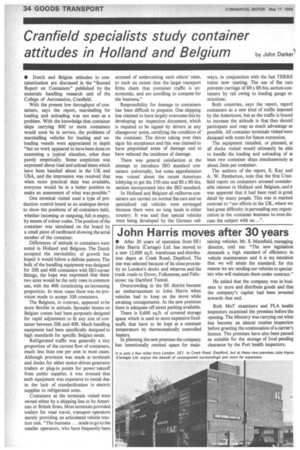Cran field specialists study container
Page 36

If you've noticed an error in this article please click here to report it so we can fix it.
attitudes in Holland and Belgium by John Darker
• Dutch and Belgian attitudes to containerization are discussed in the "Second Report on Containers" published by the materials handling research unit of the College of Aeronautics, Cranfield.
With the present low throughput of containers, says the report, marshalling for loading and unloading was not seen as a problem. With the knowledge that container ships carrying 800 or more containers would soon be in service, the problems of marshalling vehicles for loading and unloading vessels were appreciated in depth "but no work appeared to have been done on examining a typical situation, other than purely empirically. Some scepticism was expressed about load and unload times which have been bandied about in the UK and USA, and the impression was received that when more practical data was available, everyone would be in a better position to make an assessment of what was possible."
One terminal visited used a type of production control board as an analogue device to show the positions of all containers held, whether incoming or outgoing, full or empty, by means of colour codes. The position of the container was simulated on the board by a small piece of cardboard showing the serial number of the container.
Differences of attitude to containers were noted in Holland and Belgium. The Dutch accepted the inevitability of growth but hoped it would follow a definite pattern. The bulk of the handling equipment was designed for 20ft and 4011 containers with ISO corner fittings, the hope was expressed that these two sizes would be the only ones in common use, with the 40ft constituting an increasing proportion. In most cases there was no provision made to accept 30ft containers.
The Belgians, in contrast, appeared to be more flexible in attitude. Spreader beams on Belgian cranes had been purposely designed for rapid adjustment to fit any size of container between 20ft and 4011. Much handling equipment had been specifically designed to high standards for specific Belgian needs.
Refrigerated traffic was generally a tiny proportion of the current flow of containers, much less than one per cent in most cases. Although provision was made at terminals and docks for either motor-driven generator trailers or plug-in points for power takeoff from public supplies, it was stressed that such equipment was expensive to install due to the lack of standardization in electric supplies to refrigerated units.
Containers at the terminals visited were owned either by a shipping line or by American or British firms. Most terminals provided trailers for road travel, transport operators merely providing an articulated vehicle traction unit. "The business. . tends to go to the smaller operators, who have frequently been accused of undercutting each others' rates, to such an extent that the larger transport firms claim that container traffic is uneconomic, and are unwilling to compete for the business," Responsibility for damage to containers has been difficult to pinpoint. One shipping line claimed to have largely overcome this by developing an inspection document, which is required to be signed by drivers at any changeover point, certifying the condition of the container. The driver taking over then signs his acceptance and this was claimed to have pinpointed areas of damage and to have reduced the incidence of damage.
There was general satisfaction at the attempt to introduce ISO standard containers universally, but some apprehension was voiced about the recent American lobbying to get the 3511-size and 811 x 811 fin. section incorporated into the ISO standard.
In Holland and Belgium all railbome containers are carried on normal flat cars and no specialized rail vehicles were envisaged because there were no long hauls in either country. It was said that special vehicles were being developed by the German rail
ways, in conjunction with the fast TERRE trains now starting. The use of flat cars prevents carriage of 8ft x 811 6in. section containers by rail owing to loading gauge restrictions.
Both countries, says the report, regard containers as a new kind of traffic imposed by the Americans, but as the traffic is bound to increase the attitude is that they should participate and reap as much advantage as possible. All container terminals visited were designed with room for future expansion.
The equipment installed, or planned, at all docks visited would ultimately be able to handle the loading and unloading of at least two container ships simultaneously at about 2min per container.
The authors of the report, E. Kay and A. W. Pemberton, note that the first C ranfield report on containers aroused considerable interest in Holland and Belgium, and it was apparent that it had been read in great detail by many people. This was in marked contrast to "our efforts in the UK, where we had great difficulty in persuading any organization in the container business to even discuss the subject with us.. .".




























































































































